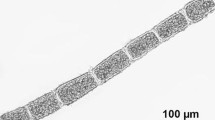Abstract
We investigated the survival of Cryptosporidium oocysts and Giardia cysts during winter in an aquatic environment (approximate temperature measurements between 1 and 7°C) in Norway, using morphology and uptake of dyes as indicators of viability. Previous research has shown that in the terrestrial environment, shear forces caused by freeze and thaw cycles probably cause the parasites to be inactivated. Such forces occurred infrequently in the aquatic environment, as freezing of the water around the parasites was not observed during the study period (although freezing of the water surface did occur). The rate of decline in viability (log10 N t/N 0) was similar in control and experimental environments for both parasites; no Cryptosporidium oocysts with viable morphology were detected after approximately 20 weeks and no Giardia cysts with apparently viable morphology could be detected after 1 month. These results suggest that infection with these parasites in Norway is not usually from transmission stages that have overwintered in the Norwegian environment.




Similar content being viewed by others
References
Campbell, AT, Robertson, LJ, Smith, HV (1992) Viability of Cryptosporidium parvum oocysts: correlation of in vitro excystation with inclusion or exclusion of fluorogenic vital dyes. Appl Environ Microbiol 58: 3488–3493
Fayer, R, Nerad, T (1996) Effects of low temperatures on viability of Cryptosporidium parvum oocysts. Appl Environ Microbiol 62: 1431–1433
Fayer, R, Trout, JM, Jenkins, MC (1998) Infectivity of Cryptosporidium parvum oocysts stored in water at environmental temperatures. J Parasitol 84: 1165–1169
Jenkins, MB, Walker, MJ, Bowman, DD, Anthony, LC, Ghiorse, WC (1999) Use of a sentinel system for field measurements of Cryptosporidium parvum oocyst inactivation in soil and animal waste. Appl Environ Microbiol 65: 1998–2005
Robertson, LJ (2005) Drikkevann: Giardia-utbruddet i Bergen—en vekker for oss alle. Hva vi vet om parasittene og hvor de stammer fra. [Drinking water: the Giardia outbreak in Bergen—a wake-up call for us all. What we know about the parasites and where they originate from.] Vann 2: 193–202
Robertson, LJ, Campbell, AT, Smith, HV (1992) Survival of oocysts of Cryptosporidium parvum under various environmental pressures. Appl Environ Microbiol 58: 3494–3500
Robertson, LJ, Campbell, AT, Smith, HV (1998) Viability of Cryptosporidium parvum oocysts; assessment by the dye permeability assay. Appl Environ Microbiol 64: 3544–3545
Robertson, LJ, Gjerde, B (2001) Occurrence of Cryptosporidium oocysts and Giardia cysts in raw waters in Norway. Scand J Public Health 29: 200–207
Robertson, LJ, Gjerde, B (2004) Effect of the Norwegian winter environment on Giardia cysts and Cryptosporidium oocysts. Microb Ecol 47: 359–365
Robertson, L, Gjerde, B, Hermansen, L, Hamnes, IS (2004) Epidemiological investigation of infection with Cryptosporidium and Giardia in Norway, by analysis of sewage influent. International Giardia and Cryptosporidium Conference, Amsterdam, September 2004, p 091
Robertson, LJ, Hermansen, L, Gjerde, BK, Strand, E, Alvsvåg, JO, Langeland N (2006) Application of genotyping during an extensive outbreak of waterborne giardiasis in Bergen, Norway during autumn/winter 2004. Appl Environ Microbiol 72(3)
Tveit, I, Søbstad, Ø, Kalland, I, Seim, A, Arnesen, RØ, Fennell, P (2005) Giardia-utbruddet i Bergen. Bergen Kommune and Mattilsnet, Norway. [On-line] http://www.bergen.kommune.no/info/
Walker, KJ, Leddy, K, Hagar, E (2001) Effects of combined water potential and temperature stresses on Cryptosporidium parvum oocysts. Appl Environ Microbiol 67: 5526–5529
Acknowledgments
This research was funded by the Norwegian Research Council. We acknowledge the assistance of the personnel at Oslo Kommune for river temperature measurements.
Author information
Authors and Affiliations
Corresponding author
Rights and permissions
About this article
Cite this article
Robertson, L.J., Gjerde, B.K. Fate of Cryptosporidium Oocysts and Giardia Cysts in the Norwegian Aquatic Environment over Winter. Microb Ecol 52, 597–602 (2006). https://doi.org/10.1007/s00248-006-9005-4
Received:
Revised:
Accepted:
Published:
Issue Date:
DOI: https://doi.org/10.1007/s00248-006-9005-4




